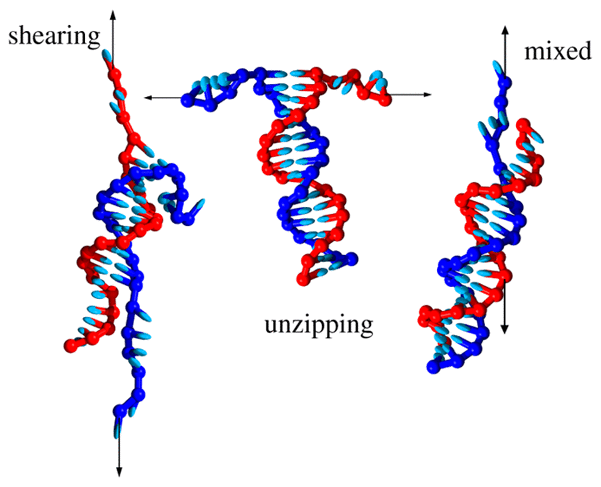|
|
Force-induced rupture of a DNA duplex: From fundamentals to force sensors
Majid Mosayebi, Ard A. Louis, Jonathan P.K. Doye and Thomas E. Ouldridge
ACS Nano 9, 11993–12003 (2015)

Abstract
The rupture of double-stranded DNA under stress is a key process in biophysics and nanotechnology. In this article we consider the shear-induced rupture of short DNA duplexes, a system that has been given new importance by recently designed force sensors and nanotechnological devices. We argue that rupture must be understood as an activated process, where the duplex state is metastable and the strands will separate in a finite time that depends on the duplex length and the force applied. Thus, the critical shearing force required to rupture a duplex within a given experiment depends strongly on the time scale of observation. We use simple models of DNA to demonstrate that this approach naturally captures the experimentally observed dependence of the critical force on duplex length for a given observation time. In particular, the critical force is zero for the shortest duplexes, before rising sharply and then plateauing in the long length limit. The prevailing approach, based on identifying when the presence of each additional base pair within the duplex is thermodynamically unfavorable rather than allowing for metastability, does not predict a time-scale-dependent critical force and does not naturally incorporate a critical force of zero for the shortest duplexes. Additionally, motivated by a recently proposed force sensor, we investigate application of stress to a duplex in a mixed mode that interpolates between shearing and unzipping. As with pure shearing, the critical force depends on the time scale of observation; at a fixed time scale and duplex length, the critical force exhibits a sigmoidal dependence on the fraction of the duplex that is subject to shearing.The full paper is available from ACS Nano, for non-subscribers from ACS articles on request and arXiv.org.